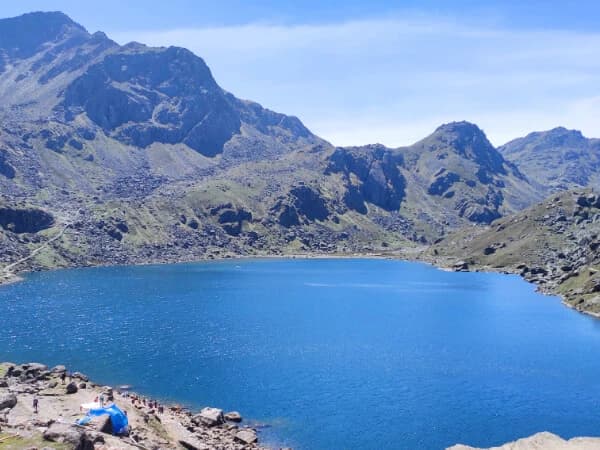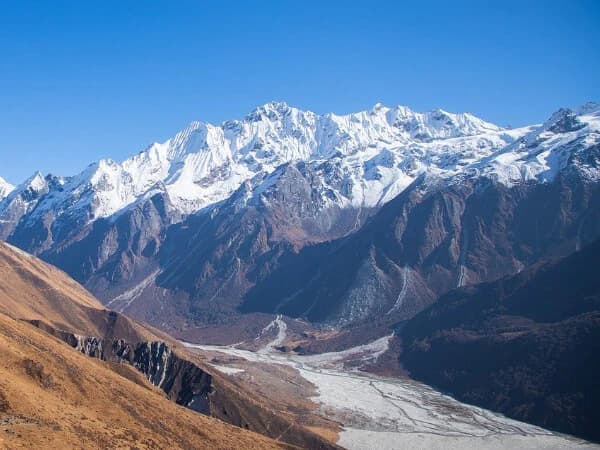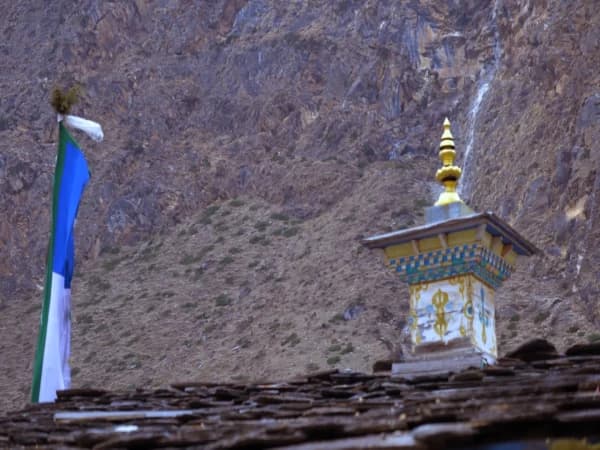Highlights of the Everest Trekking Journey
Your tour starts with a heart-pounding, 25-minute flight to Lukla, known as one of the most beautiful flight services anywhere in the world. The trek brings you through such colorful Sherpa townships as Namche Bazaar, Tengboche, Dingboche, Lobuche, and Gorakshep. On the journey, you’ll meet with descending landscapes, fields, and monasteries and see ranges of mountains such as Thamserku, Nuptse, and Island Peaks. The icing on the cake is that a visit to Kalapatthar gives one of the most rewarding views of the sunrise over the great Himalayas.
- Thrilling Flight experience to the astounding airport, Tenzing-Hillary Airport, situated at a high altitude in Lukla
- Opportunity to get a stunning aerial view of the Khumbu region
- The amazing Khumbu Glacier with Khumbu Icefall views
- An exotic home to numerous flora and wildlife species, the Sagarmatha National Park
- Entry to Everest treks, the beautiful Namche Bazaar
- Lovely Sherpa culture and traditions
- The Tengboche Monastery, the biggest and oldest monastery in the Khumbu region
- Mt. Everest, the tallest mountain in the world
- Kalapathhar, one of the best vantage points for a 360-degree panoramic view of the Everest region
- Colorful flags, prayer wheels, mani stones all route to the Everest
- High-suspension bridges with lush vegetation, dense forests
- Mesmerizing views of Mt. Everest with Mt. Lhotse, Mt. Nuptse, Mt Cho Oyu, Mt. Makalu, Mt. Pumori, Mt. Kongde, and Mt. Thamserku
Everest Trekking: A Growing Adventure for Indian Travelers
Trekking to Everest has recorded a splendid increase, and people from India in particular have been drawn to it within the past few years. India and Nepal are neighbors, closely connected by cultural and geographical events and circumstances, making the adventure easy and rewarding.
THE EVEREST TREKKING FOR INDIANS:
Our special Everest Trek package for Indian guests is to ensure that our customers get the most out of this adventure. Starting this ever-memorable and challenging journey to the Everest Base Camp is one of the most rewarding endeavors. The trek begins from Lukla and lasts about eight days, covering the standard Everest trekking path. On your travels, you will come across more great suspension bridges, become mesmerized by monasteries that are predominantly Buddhist, and get to know the modern lifestyle of the Sherpa. At 5364 meters, the Base Camp offers spectacular views of the World’s highest mountain and other giants such as Lhotse (8501m), Makalu (8463m), Cho Oyu (8153m), and the beautiful Ama Dablam (6856 m).
Why should Indians choose the Everest Trek?
Everything ranging from accommodation in warm tea houses to guided hiking with Sherpas is part of our expertly crafted itinerary. Indian travelers gain on the cost side as they do not require a visa to travel to Nepal, and the trekking permit fees are considerably cheaper. This makes the Everest trek within reach for the Indian enthusiasts in terms of cost, and since Nepal is physically neighboring to India a the trek is easily accessible.
In its self-organized tours, special preparation is needed. Travelers must be conscious of altitude illness and ensure that they spend enough money on food and accommodation because the prices rise with the altitude. But here at our inclusive guided trek package, all these issues are addressed to ensure an organized trekking arrangement for your convenience.
Adventure on a Shoestring or How to Get the Best of the Real World for Less?
The Indian trekkers are privileged not only to get cheap services but also good services. The rates differ for people of various nationalities, but Indians can consider the Everest trek almost twice as cheap as, let’s say, Americans or Europeans. From basic tea house stays to delicious breakfast, lunch, and dinner as well as the services of experienced Sherpa guides, our package is very comprehensive.
Plan Your Trek with Altitude Insights with Us
The key knowledge is to prepare for safe and entertaining trekking because altitude differences along the Everest trails are rather significant. It is highly useful for planning where to take rests and when to take them due to altitude on our well-laid-out Everest Base Camp Trek Map with Altitude Details. Thus, this guide arms you with all the information that will help you avoid pitfalls on this trek.
The Everest Trek for Indians combines the opportunity for natural sightseeing, social interaction, and personal accomplishment at a realistic cost. We, Recreation Holidays, are pleased to take you on a journey to the Base Camp of the highest peak in the world and make your trip a most memorable one.
Who is Suitable for the Everest Trekking Package for Indians?
The Everest Trekking package, as described here, is ideal for independent trekkers or groups of travelers from the Indian subcontinent seeking an exhilarating gateway to Nepal’s spectacular Everest Territory. Designed for a particular country, India, this package takes into account special requests to meet, for example, the diet and cultural requirements that may be quite sensitive for trekkers. In this way, the discovered package is great for experienced travelers and novices who do not want to stray far from the familiar.
GUIDERS & ADVENTURE- Fitness lovers & Hiking lovers will love to travel through the Everest region since the area has steep land, a long trail, and a view of the Himalayan chain. This trek is ideal for those who are physically strong and ready for challenges. But equally so, nature enthusiasts may have exploitable access and interest in exotic, serene settings such as the view of Mount Everest and other hills, glaciers, and valley greenery.
For those who have an interest in cultural sites, it allows visiting the fabulous Sherpa people who live nearby and dominate in mountaineering and have their colorful traditions. Indian travelers can fully experience the local culture without being completely away from home, and are given specific services to their preference. The Everest Trekking package is around popular destination for nature and adventure, complemented with a rich cultural experience, perfected for Indian travelers.
Benefits of Booking Everest Trekking for Indians with Us
When you book your Everest Trek with us, you gain access to a range of exclusive benefits designed to enhance your experience and ensure a hassle-free journey:
- Convenient Transportation: Enjoy international and domestic airport pickup and drop-off services for a smooth start and end to your trip.
- Gear arrangement at a lesser cost: You can get your gear at a lesser cost. We can arrange it according to your choices. Perfect for your trekking adventure.
- Trekking Essentials: We provide you with an Everest Base Camp Trek map to guide you through the trails.
- Health and Safety Support: We provide an oximeter to monitor blood oxygen saturation levels during high-altitude trekking, along with medical kits for emergencies.
- Secure Luggage Storage: Store your excess luggage safely at the Recreation Holidays office while you are on your trek.
Prepare your necessary Documents as follows:
Passport: Please note that Indian travelers must have either of the following documents as a VALID TRAVEL DOCUMENT.
- Valid Indian Passport with at least six months of validity
- Voter ID (Election ID) card issued by the Election Commission of India.
You have to present one of these Valid IDs at the immigration checkpoints while traveling to Nepal.
Visa: A Nepal Tourist Visa must be acquired either online or at the airport immediately upon arrival in Kathmandu.
Permits: TIMS (Trekkers Information Management System) and Sagarmatha National Park Permit. We help with these permits before your trek starts.
Make Advance Payment: Our company policy is to pay 20-30% of the trekking amount for a booking. You can pay using credit cards or online banking transfers. Check your preferred payment method.
Book Flights:
International Flight: You fly to Kathmandu, Nepal, from any neighboring Indian airport of your choice.
Domestic Flight: We book your Kathmandu-Lukla flight, which is the flying start for the Everest treks, after receiving your documents and confirmation of travel dates.
Arrange Travel Insurance: Ensure you get all-inclusive travel insurance, which has provisions for trekking up to, and including, 6000 meters, and helicopter evacuations in case of injuries or medical complications. It has become compulsory for most of the trekking agencies, and it favors you and your budget.
Pack Proper Gear: A list of necessary garments for trekking, trekking shoes, trekking jackets, sleeping bags, and sundry items such as trekking sticks. We provide you with a detailed list of gear.
Everest Trekking for Indians: Distance, Duration, and Altitude
| Trekking Route | Altitude (Meters) | Distance (Kilometers or Miles) |
Duration (Hours) |
| Lukla to Phakding | 2610 | 7.8km or 4.8 mi | 3 to 4 |
| Phakding to Namche Bazaar | 3440 | 10.4km or 6.5 mi | 5 to 7 |
| Namche Bazaar to Tengboche | 3810 | 9.2km or 5.7 mi | 5 to 7 |
| Tengboche to Dingboche | 4410 | 9.1km or 5.6 mi | 4 to 6 |
| Dingboche to Lobuche | 4920 | 7.9km or 4.9 mi | 4 to 6 |
| Lobuche to Gorakshep | 5140 | 4.5km or 2.8 mi | 3 to 4 |
| Gorakshep to Everest Base Camp | 5364 | 3.5km or 2.17 mi | 3 to 5 |
| Gorakshep to Kalapatthar | 5545 | 2km or 1.2 mi | 2 to 3 |
| Gorakshep to Pangboche | 3985 | 13.8km or 8.5 mi | 5 to 7 |
| Pangboche to Namche Bazaar | 3440 | 19.3km or 11.99 mi | 6 to 8 |
| Namche Bazaar to Lukla | 2840 | 13.5km or 8.3 mi | 7 to 9 |
What are the expectations from Everest Trekking for Indians?
- Scenic Flights to Lukla: Your journey of Everest Trekking for Indians begins with a thrilling flight from Kathmandu to Lukla, one of the world’s most exciting airports, offering breathtaking views of the Himalayan ranges.
- Immersive Himalayan Landscapes: You will be offered to witness the towering snow-capped peaks like Mount Everest, Lhotse, Nuptse, and Ama Dablam. Everest Trekking traverses through serene valleys, suspension bridges, and pristine glaciers.
- Cultural Encounters with Sherpa Communities: During the Everest Trek, you will experience the warm hospitality of the local Sherpa people. Visiting the traditional villages like Namche Bazaar lets you learn about their culture, traditions, and way of life.
- Sacred Monasteries and Spiritual Vibes: The peace you feel during a visit to the ancient monasteries, including Tengboche Monastery, allows you can soak yourself in the spiritual atmosphere and participate in Buddhist rituals.
- Diverse Trekking Terrain: Trek through lush rhododendron forests, alpine meadows, and rocky moraines. Each day brings unique challenges and incredible scenery.
- Spectacular Views from Kala Patthar: Climb Kala Patthar, a famous viewpoint, to enjoy a panoramic view of Mount Everest and surrounding peaks during sunrise or sunset.
- Acclimatization Days for High-Altitude Adjustment: Carefully planned acclimatization days in places like Namche Bazaar and Dingboche help your body adjust to the altitude, ensuring a safer trek.
- Comfortable Tea Houses and Local Cuisine: Stay in cozy tea houses offering basic amenities, warm meals, and traditional meals like dal bhat, momo, chowmein, pizza, and Sherpa stew.
- Everest Base Camp Milestone: Reach the iconic Everest Base Camp, standing amidst the world's highest mountains, and take pride in accomplishing this extraordinary feat.
- Adventure and Personal Growth: Expect physical and mental challenges that push your limits, helping you build resilience, confidence, and a lifelong sense of achievement.
- High-Altitude Thrills with Safety First: Experience the thrill of high-altitude trekking while following safety guidelines for altitude sickness and emergencies.
- Connection with Fellow Trekkers: Make bonds with fellow trekkers from around the world, creating memories and friendships that last a lifetime.
Preparation required for Everest Trekking for Indians
Preparing for an Everest trek requires physical fitness, proper gear, and mental readiness. Begin by engaging in regular physical training at least three months before your trek. Focus on cardio exercises like running, cycling, or swimming to build stamina, along with strength training to enhance endurance. Practice hiking on uneven terrains with a loaded backpack to simulate trekking conditions. Acclimatization is crucial for high-altitude trekking, so learn breathing techniques and gradually increase your exposure to higher altitudes through shorter treks or weekend hikes in the Himalayas.
A successful trek mostly depends on the kind of clothes one wears during the exercise. Ensure you buy good-quality trekking boots, traveling clothes that avoid overexposure, a strong rucksack, and trekking sticks. Hiking items include a sleeping bag, headlamp, tablets to purify water, and a medical kit with medicines for altitude sickness. Limit luggage but do not leave home without essentials, as this part of the world can experience some real weather changes. This is because most trekking agencies usually prepare a packing checklist that helps hikers not forget some important items. We do provide you with a checklist for packing essentials for your trek.
Mental preparation is equally important. Trekking to Everest involves long hours of walking, steep ascents, and challenging weather conditions. Stay positive, remain patient, and prepare yourself for unpredictable situations. Please educate yourself about altitude sickness symptoms and how to handle them. It’s also essential to have travel insurance that covers high-altitude trekking and emergency evacuations. Familiarize yourself with Nepal’s trekking permits like TIMS and Sagarmatha National Park Entry Permit, which are mandatory. With proper preparation, you can turn your Everest trek into a rewarding and unforgettable experience.
Cost of Everest Trekking for Indians 2025/2026
This package, Everest Trekking for Indians 2025/2026, is specially designed for Indian citizens. The cost of Everest trekking for Indians in 2025/2026 varies depending on the trekking package, duration, and level of service. On average, the total expense ranges between ₹1,00,000 and ₹2,50,000 per person, covering permits, guide and porter fees, domestic flights (Kathmandu-Lukla-Kathmandu), accommodation in tea houses, and meals during the trek. Budget options may be slightly lower, while premium packages with added services like helicopter returns or luxury lodges cost more. Additional costs include international flights to Kathmandu, travel insurance covering high-altitude trekking, gear rental or purchase, and personal expenses like snacks, tips, or Wi-Fi usage. Booking in advance and choosing a reliable trekking agency can help secure competitive rates for a seamless trekking experience.
| No. of Pax | Starting Price | Action |
| 1 | USD 1260 for solo trekker | Inquire Now |
| 2 to 4 | USD 1055 per person | Inquire Now |
| 5 to 8 | USD 999 per person | Inquire Now |
| 9+ | USD 970 per person | Inquire Now |
Note: This package is only applicable to Indian Travelers, possessing those documents mentioned above. If any Indian do not have any of those documents, the cost of Everest Trekking for Indians will be different.











